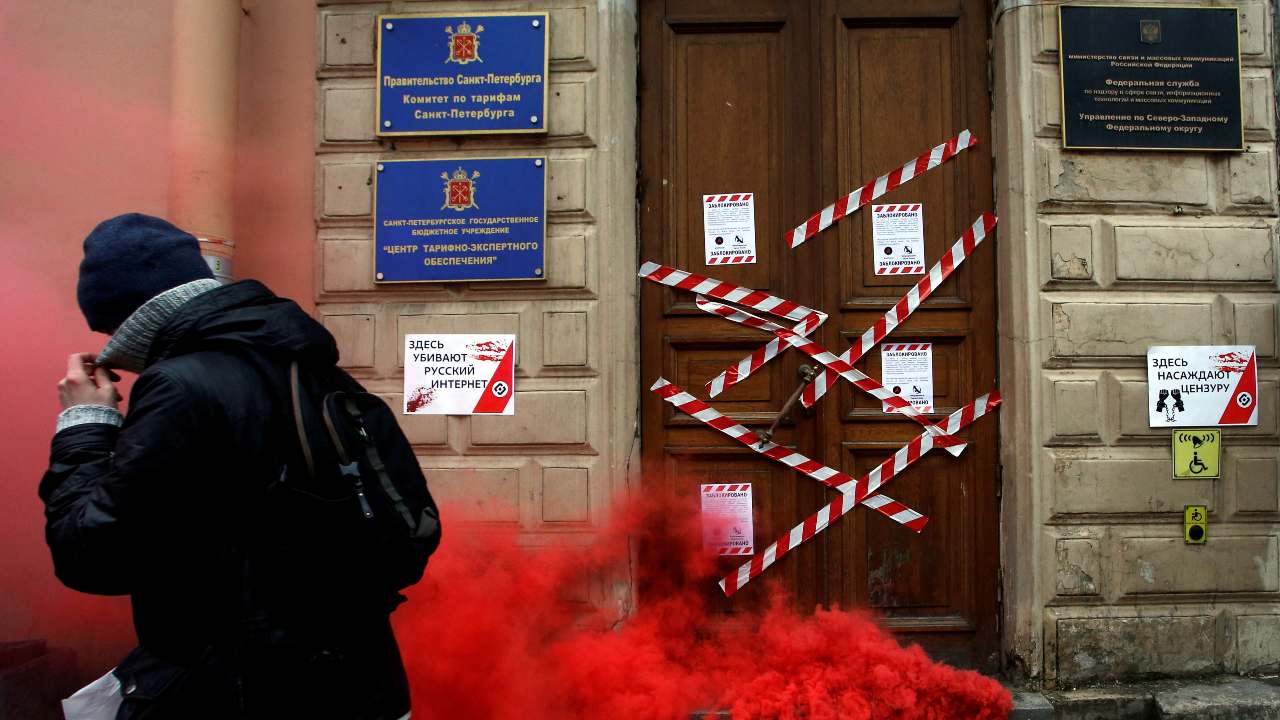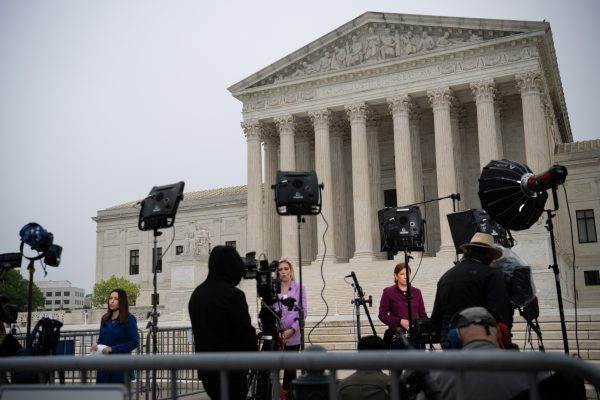As Russia sends tanks and soldiers to take over Ukraine, it is also dispatching censors and regulators to strangle the Internet. In this special series by the Center for European Policy Analysis, The New Iron Curtain, Senior Fellows Andrei Soldatov and Irina Borogan argue that both invasions are linked and represent the culmination of a more than a decade-long trend to throttle the free and open flow of information in Russia.
For years, former KGB generals watched the growth of the Internet with suspicion, believing it was a threat to Russia’s national security. They vowed to disable it.
Their leader was Vladislav Sherstyuk, a career KGB officer. In 1998, he became director of FAPSI, the division of the intelligence service in charge of spying on foreign communications and the protection of the government’s most sensitive networks. The next year, President Putin promoted Sherstyuk to the powerful Security Council, where he supervised the information security department. In 2000, his team composed the ‘Information Security Doctrine of the Russian Federation’, a plan for the future of the Russian internet.
Its doctrine reflects the KGB mindset: the free flow of information, coming from the West, poses a threat to Russia’s national security. Threats ranged from a “devaluation of spiritual values” to a “reduction of the spiritual, moral and creative potential of the Russian population,” as well as the “manipulation of information (disinformation, concealment or misrepresentation).” Putin signed the document, and the Security Council became the ideological center of operations to curb Russian Internet freedom and the force behind the nascent Sovereign Internet.
In November 2017, the Security Council instructed the Ministry of Communications to submit “proposals for the creation and implementation of a state information system to ensure the integrity, stability, and security of the Russian segment of the Internet, as well as replacement root servers for national top-level domain names.” The Security Council warned: “A serious threat to the security of the Russian Federation is the increased capabilities of Western countries to conduct offensive operations in the information space and readiness to use them.”
Officially, the Security Council aimed to make the Russian Internet sustainable and self-sufficient. In fact, the Kremlin wanted to build an effective system of control. The Kremlin identified six challenges to overcome:
- The major threat to the Kremlin’s narrative does not come from abroad, but from within Russia.
During the Cold War, the Kremlin saw the most dangerous content coming from Western media. This content could be found on the Internet, but Russians preferred and trusted domestic content.
Opposition leader Alexei Navalny’s documentaries about Kremlin corruption attracted record YouTube audiences. In 2017, Navalny’s YouTube video about Russian Prime Minister Dmitri Medvedev’s alleged corruption was viewed more than 22 million times. Since then, Navalny’s organization has produced anti-corruption videos on YouTube on an industrial scale. These videos are more popular than content created by Radio Free Europe, Voice of America, or the BBC.
The Kremlin began to pressure both local and Western technology companies to take down opposition content critical to authorities.
- Ordinary Russians who witness something extraordinary and post it online are more dangerous than activists.
When ordinary people witness a natural disaster, a technical catastrophe, or police brutality – and share the evidence – through video or photos — the posts go viral. The information spreads too quickly for the censorship system to address.
The Kremlin began to set up a Moscow control center, giving it the ability to oversee access to the entire Russian Internet.
- Russians prefer global apps to local apps.
Censors understand that activists use apps such as Signal or software such as Tor to obscure their communications, but ordinary Russians depend on mainstream consumer apps such as WhatsApp, Viber (a communications app owned by the Japanese company Rakuten), Telegram, and TikTok.
The Kremlin aimed to change reliance on Western apps to local ones that the security services could control and suppress.
- Video is the online content most likely to generate mass protests.
YouTube and TikTok’s explosive growth took Russian authorities by surprise. In 2017, Navalny’s documentary about Medvedev’s corruption encouraged Russian YouTubers to spread videos showing police brutality used to crack down on protests. Russian schoolchildren filmed their teachers raging about enemies of the state and posted the videos.
The Kremlin concentrated its censorship efforts on video posts, filing numerous complaints to YouTube about the Navalny videos, and arresting the editor of Navalny Live.
- The decentralized Internet allows events not just in Moscow or St. Petersburg but from anywhere in the vast country to be publicized and promoted.
In August 2018, tensions rose in the majority Muslim region of Ingushetia over a Kremlin-supported border-swap agreement with neighboring Chechnya. On the day of the agreement’s signing, about a hundred people gathered to protest in the Ingush capital, Magas.
Ingushetia’s Internet was cut. Authorities suppressed live streaming. In the following weeks, the Ingush kept going to the streets to protest, and the FSB Secret Service enforced web shutdowns.
Despite the efforts, information about protests kept leaking. The Kremlin’s new system, controlled through a single center in Moscow, was built to shut down the Internet to entire regions, allowing it to act without relying on regional enforcers.
- Russian telecom companies are unwilling to pick up the bill for censorship and surveillance tools.
Starting in the 1990s, Russian telecom companies were required to buy and update equipment for online surveillance. Starting in 2018, Russians were obliged to store the complete data of all users for six months, and their metadata for three years.
Telecom companies protested. Sometimes, their resistance became public – company officials expressed their concerns at conferences and to journalists. In most cases, the resistance stayed private. Companies attempted to find a way around the legislation, for instance, by renting surveillance equipment from large operators. This resistance undermined the effectiveness of the Russian nationwide surveillance and filtering.
Kremlin censors realized that they needed to pay companies to install censorship and surveillance tools. They began providing Internet service providers with special equipment which gave the government the means to suppress and redirect the traffic to the control center in Moscow.
The Sovereign Internet was born. It would be built out over the next few years, in advance of the decision to invade Ukraine.
Andrei Soldatov is a nonresident senior fellow with the Center for European Policy Analysis. Andrei is a Russian investigative journalist, co-founder, and editor of Agentura.ru, a watchdog of the Russian secret services’ activities. He has been covering security services and terrorism issues since 1999.
Irina Borogan is a nonresident senior fellow with the Center for European Policy Analysis. Irina is a Russian investigative journalist, co-founder, and deputy editor of Agentura.ru, a watchdog of the Russian secret services’ activities.
READ MORE

Part 4: Russia’s Sovereign Internet Takes Root
In May 2019, Vladimir Putin signed new legislation to shut Russians off from information contradicting the Kremlin’s approved narrative. Western technology helped build the censorship apparatus.
Bandwidth is CEPA’s online journal dedicated to advancing transatlantic cooperation on tech policy. All opinions are those of the author and do not necessarily represent the position or views of the institutions they represent or the Center for European Policy Analysis.





